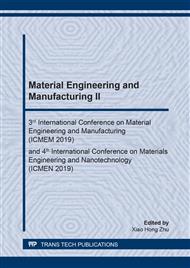[1]
Li, BH, Gao, HJ. Deng, HB et al. Investigation on the influence of the equivalent bending stiffness of the thin-walled parts on the machining deformation. Int J Adv Manuf Technol, 2018. https://doi.org/10.1007/s00170-018-2987-5.
DOI: 10.1007/s00170-018-2987-5
Google Scholar
[2]
Gao HJ, Zhang YD, Wu Q, Song J. Experimental investigation on the fatigue life of Ti-6Al-4V treated by vibratory stress relief. Metals (Basel), 2017(7):158. https://doi.org/10.3390/met7050158.
DOI: 10.3390/met7050158
Google Scholar
[3]
Gao HJ, Zhang YD, Wu Q, Song J, Wen K. Fatigue life of 7075- T651 aluminium alloy treated with vibratory stress relief. Int J Fatigue, 2018(108):62–67. https://doi.org/10.1016/j.ijfatigue.2017.11.011.
DOI: 10.1016/j.ijfatigue.2017.11.011
Google Scholar
[4]
Wu Q, Li DP, Zhang YD. Detecting milling deformation in 7075 aluminum alloy aeronautical monolithic components using the quasi-symmetric machining method. Metals (Basel), 2016, 6:80. https://doi.org/10.3390/met6040080.
DOI: 10.3390/met6040080
Google Scholar
[5]
Gao HJ, Zhang YD, Wu Q, et al. An analytical model for predicting the machining deformation of a plate blank considers biaxial initial residual stresses. International Journal of Advanced Manufacturing Technology, 2017, 93(1-4): 1473–1486.
DOI: 10.1007/s00170-017-0528-2
Google Scholar
[6]
Gao HJ, Zhang YD, Wu Q, et al. Investigation on Influences of Initial Residual Stress on Thin-walled Part Machining Deformation Based on a Semi Analytical Model. Journal of Materials Processing Technology, 2018, 262: 437-448.
DOI: 10.1016/j.jmatprotec.2018.04.009
Google Scholar
[7]
Wang SH. Study on Initial Residual Stresses and Their Effects on Milling Distortion for Thick Aero-Aluminum-Alloy Plate: Nanjing University of Aeronautics and Astronautics, (2005).
Google Scholar
[8]
Sun J, Ke YL. Study on machining distortion of unitization airframe due to residual stress. Chinese Journal of Mechanical Engineering. 2005. 41(2): 117-122.
DOI: 10.3901/jme.2005.02.117
Google Scholar
[9]
Tang ZT, Yu T, Xu LQ et al. Machining deformation prediction for frame components considering multifactor coupling effects. International Journal of Advanced Manufacturing Technology. 2013. 68(1-4): 187-196.
DOI: 10.1007/s00170-012-4718-7
Google Scholar
[10]
Guo H, Zuo DW, Wu HB et al. Prediction on milling distortion for aero-multi-frame parts. Materials Science & Engineering A. 2009. 499(1): 230-233.
DOI: 10.1016/j.msea.2007.11.137
Google Scholar
[11]
Liu LB, Sun JF, Chen WY et al. Study on the machining distortion of aluminum alloy parts induced by forging residual stresses. Proceedings of the Institution of Mechanical Engineers Part B Journal of Engineering Manufacture. 2015. 231(4):.
DOI: 10.1177/0954405415583805
Google Scholar
[12]
Richter-Trummer V, Koch D, Witte A et al. Methodology for prediction of distortion of workpieces manufactured by high speed machining based on an accurate through-the-thickness residual stress determination. International Journal of Advanced Manufacturing Technology. 2013. 68(9-12): 2271-2281.
DOI: 10.1007/s00170-013-4828-x
Google Scholar
[13]
Jiang ZL, Liu YM, Li L et al. A novel prediction model for thin plate deflections considering milling residual stresses. International Journal of Advanced Manufacturing Technology. 2014. 74(1-4): 37-45.
DOI: 10.1007/s00170-014-5952-y
Google Scholar
[14]
Rémi Husson, Cyrille Baudouin, Régis Bigotet al. Consideration of residual stress and geometry during heat treatment to decrease shaft bending. International Journal of Advanced Manufacturing Technology. 2014. 72(9-12): 1455-1463.
DOI: 10.1007/s00170-014-5688-8
Google Scholar
[15]
Yang Y, Li M, Li K R. Comparison and analysis of main effect elements of machining distortion for aluminum alloy and titanium alloy aircraft monolithic component. International Journal of Advanced Manufacturing Technology. 2014. 70(9-12): 1803-1811.
DOI: 10.1007/s00170-013-5431-x
Google Scholar
[16]
Zhang Z, Li L, Yang YF et al. Machining distortion minimization for the manufacturing of aeronautical structure. International Journal of Advanced Manufacturing Technology. 2014. 73(9-12): 1765-1773.
DOI: 10.1007/s00170-014-5994-1
Google Scholar


